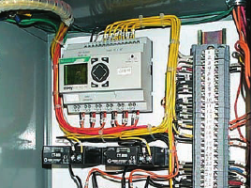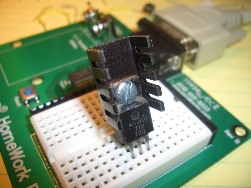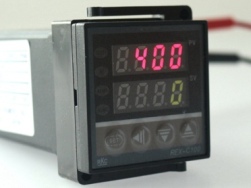LD Ladder Language and its Application
 The ladder or ladder diagram language LD (from the English Ladder Diagram) is an easy-to-use, graphical development language. It is based on relay-contact circuits, so the logic elements here are: relay windings, relay contacts, horizontal and vertical jumpers.
The ladder or ladder diagram language LD (from the English Ladder Diagram) is an easy-to-use, graphical development language. It is based on relay-contact circuits, so the logic elements here are: relay windings, relay contacts, horizontal and vertical jumpers.
A pair of relay contacts or buttons are the main logical variables of the LD language, while the state of the variables is nothing more than the state of the contacts: open or closed. The program itself in this graphic language seems to be an analogue of the relay circuit, which can include many different functional blocks. In general, the syntax of the LD language makes it very easy to build logic circuits for relay technology. As such, the language of relay circuits existed in the time of Thomas Edison, and only in the early 1970s it was adapted for the first PLCs ...
The device and the principle of battery operation
 An electric battery is a reusable chemical current source. The chemical processes inside the battery, in contrast to those in disposable galvanic cells, such as alkaline or salt batteries, are reversible. The cycles of charge-discharge, accumulation and return of electrical energy can be repeated many times.
An electric battery is a reusable chemical current source. The chemical processes inside the battery, in contrast to those in disposable galvanic cells, such as alkaline or salt batteries, are reversible. The cycles of charge-discharge, accumulation and return of electrical energy can be repeated many times.
So, the principle of operation of the battery allows you to cyclically use it for autonomous power supply of a variety of devices, portable devices, vehicles, medical equipment, etc. in completely different areas. Speaking the word "battery", they mean either the battery itself or the battery cell. Several series or parallel connected to each other battery cells form a battery, as well as several connected batteries. The first battery, that is, a galvanic cell ...
How to calculate the radiator for a transistor
 Often, when designing a powerful device on power transistors, or resorting to the use of a powerful rectifier in the circuit, we are faced with a situation when it is necessary to dissipate a lot of thermal power, measured in units, and sometimes tens of watts.
Often, when designing a powerful device on power transistors, or resorting to the use of a powerful rectifier in the circuit, we are faced with a situation when it is necessary to dissipate a lot of thermal power, measured in units, and sometimes tens of watts.
For example, Fairchild Semiconductor's FGA25N120ANTD IGBT transistor, if installed correctly, is theoretically capable of delivering about 300 watts of thermal power through its chassis at a chassis temperature of 25 ° C! And if the temperature of its case is 100 ° C, then the transistor will be able to give 120 watts, which is also quite a lot. But in order for the transistor case, in principle, to be able to give this heat, it is necessary to provide it with proper working conditions so that it does not burn out ahead of time. All power switches are issued in such cases which can be easily installed on an external heat sink - a radiator ...
Which temperature sensor is better, sensor selection criteria

First of all, it is necessary to find out the following details: the expected temperature range of measurements, the required accuracy, whether the sensor will be located inside the medium (if not, a radiation thermometer will be needed), the conditions are assumed normal or aggressive, is the possibility of periodic dismantling of the sensor important, and finally, is it necessary graduation is in degrees or it is acceptable to receive a signal, which will then be converted into a temperature value.
These are not idle questions, answering which the consumer gets the opportunity to choose for himself a more suitable temperature sensor with which his equipment will work in the best way. Of course, one cannot simply and unequivocally answer the question of which temperature sensor is better, the choice remains to be made to the consumer, having previously familiarized himself with the features of each type of sensor ...
Why does the plug spark in the outlet when turning the circuit on and off
 Why does the plug spark in the socket when turning the load on and off, sometimes even when the plug is plugged in and keeps stationary in the socket? Have you ever asked such a question, did this happen to you? But this is not an idle question, and it would be good to find and eliminate the reason before it comes to the fire.
Why does the plug spark in the socket when turning the load on and off, sometimes even when the plug is plugged in and keeps stationary in the socket? Have you ever asked such a question, did this happen to you? But this is not an idle question, and it would be good to find and eliminate the reason before it comes to the fire.
Meanwhile, the cause of the sparking is by no means obvious, although in principle there are few options: it can either be a loose fit of the plug pins to the socket, or the contacts or wires inside the socket may at some point not be able to conduct the operating current of the device normally, and it turns out overload of one of the contact joints by current, which is ultimately accompanied by sparking. What could result in poor contact between the pins and the outlet? Contact clamps are installed inside the outlet, they can diverge greatly over time and become unable to tighten the plug pins. A fork, for one, may have ...
 In order to mark, fasten or assemble cables during electrical installation, it is very convenient and advantageous to use cable ties. These plastic clamps allow you to quickly, safely and efficiently complete the installation of the cable system in compliance with high quality and reliability requirements.
In order to mark, fasten or assemble cables during electrical installation, it is very convenient and advantageous to use cable ties. These plastic clamps allow you to quickly, safely and efficiently complete the installation of the cable system in compliance with high quality and reliability requirements.
These products are called today differently: cable ties, nylon cable ties, cable ties, plastic ties - we are always talking about the same product, the very first sample of which was invented and patented back in 1958 in the United States by Sir Maurus Logan, Thomas & Betts, a design engineer at the time, was manufacturing cable for submarines and aircraft. The idea came to the inventor from scratch. Initially, cables on aircraft and submarines tied one to another with a thread ...
Functional and safe electrics for gardening
 The choice of wiring accessories for a summer residence, as well as conducting electrical work, requires special attention to the quality of materials. Especially when it comes to a wooden house. If this important aspect is neglected, the consequences can vary, ranging from problems with power supply to the risk of fire.
The choice of wiring accessories for a summer residence, as well as conducting electrical work, requires special attention to the quality of materials. Especially when it comes to a wooden house. If this important aspect is neglected, the consequences can vary, ranging from problems with power supply to the risk of fire.
Having correctly calculated the necessary load and correctly conducting the wiring, it is important to choose high-quality wiring products, clearly predict the required number of sockets and switches, and also take into account exactly where they will be installed. If you plan to install outside, for example, on the porch, it is worth considering the possible temperature changes, exposure to sunlight, rain or other natural factors. In this case, it is better to avoid products made of polycarbonate, yellowing under the influence of the sun ...
 PID (from the English P-proportional, I-integral, D-derivative) - a regulator is a device used in control loops equipped with a feedback link. These controllers are used to generate a control signal in automatic systems where it is necessary to achieve high requirements for the quality and accuracy of transients.
PID (from the English P-proportional, I-integral, D-derivative) - a regulator is a device used in control loops equipped with a feedback link. These controllers are used to generate a control signal in automatic systems where it is necessary to achieve high requirements for the quality and accuracy of transients.
The control signal of the PID controller is obtained by adding three components: the first is proportional to the value of the error signal, the second is the integral of the error signal, and the third is its derivative. If any of these three components is not included in the addition process, then the controller will no longer be PID, but simply proportional, proportionally differentiating or proportionally integrating. The output signal gives a proportional component. This signal leads to counteraction to the current deviation of the input quantity ...
